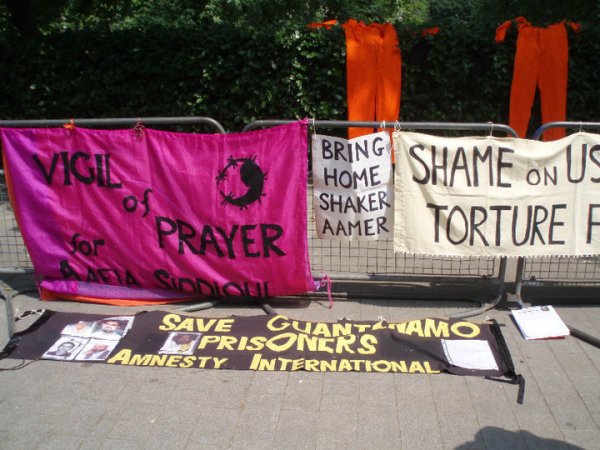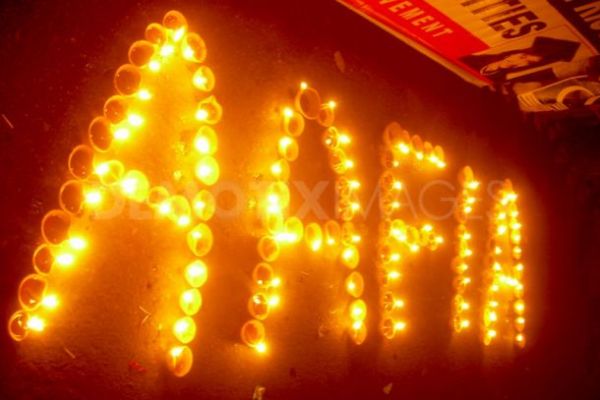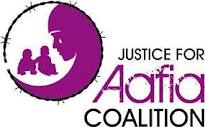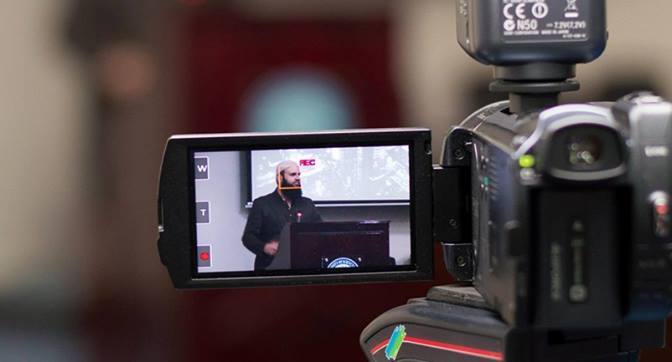
BACKGROUND
Dr. Aafia Siddiqui was born on 2 March 1972 in Karachi, Pakistan. She is one of three siblings. Aafia’s father Mohammad Siddiqui was a UK-trained doctor and her mother, Ismet, is a homemaker. Aafia has three children: Ahmed (b. 1996), Maryam (b. 1998), and Suleman (b. 2002), the latter of whom remains missing to this day.
Aafia moved to Texas in 1990 to be near her brother, and after spending a year at the University of Houston, transferred to Massachusetts Institute of Technology (MIT). Siddiqui’s fellow students say she was a quiet, studious woman who was devout in her religious beliefs. A fellow student, Hamza, recalled in an interview with the BBC, “I remember Aafia as being sweet, mildly irritating but harmless”.
During her time at MIT, Aafia joined the campus Muslim Student Association (MSA) and was actively involved in efforts to portray the teachings of Islam to non-Muslims in order to better their understanding of her faith and invite them to Islam. Her emphasis in her life on bettering the conditions of Muslims even pervaded her academic achievements. During her sophomore year at MIT, she won a grant of $5,000 to study the effects of Islam on women living in Pakistan. In addition to her many academic achievements, Aafia earned the honourable status of committing the entire Qur’an to memory.
Following her graduation, Aafia married a medical student Mohammed Amjad Khan. She subsequently entered Brandeis University as a graduate student in cognitive neuroscience. Citing the difficulty of living as Muslims in the United States after 9/11 and following FBI harassment of her husband, Aafia and her husband returned to Pakistan. They stayed in Pakistan for a short time, and then returned to the United States. They remained there until 2002, and then moved back to Pakistan. Some problems developed in their marriage, and Aafia was eight months pregnant with their third child when she and Khan were separated. She and the children stayed at her mother’s house, while Khan lived elsewhere in Karachi. After giving birth to her son, Aafia stayed at her mother’s house for the rest of the year, returning to the US without her children around December 2002 to look for a job in the Baltimore area, where her sister had begun working at Sinai Hospital. On 1 March 2003, Pakistani authorities arrested Khalid Sheikh Mohammed, Aafia and her children disappeared just 27 days later.


DISAPPEARANCE
Dr. Afia Siddiqui, a highly educated researcher who studied at the Massachusetts Institute of Technology, US, for about 10 years and did her PhD in genetics, mysteriously disappeared from Karachi in March 2003 along with her three children. Since then, US and Pakistani officials have continuously denied any knowledge about her.
It was only after British prisoner Moazzam Begg mentioned her in his book The Enemy Combatant that Human Rights Organizations and activists, British journalist Yvonne Ridley and MP Lord Nazir in particular, raised voice for Dr. Aafia kept in solitary confinement and her three children. A specially disturbing part of this story is that fate of her three children, aged between one month and 7 years at the time of her kidnapping, is still unknown.
Aafia Siddiqui, In 2007, the media started giving Dr. Aafia’s case more serious attention and several reports were published about her tragic fate. Amnesty International included her on a June 2007 list as someone for whom there was “evidence of secret detention by the United States and whose fate and whereabouts remain unknown.”
Britain’s Lord Nazir Ahmed, (of the House of Lords), asked questions in the House about the condition of Prisoner 650. According to one news story, “He [Lord Nazir] said she is physically tortured and continuously raped by the officers at the prison.” Lord Nazir has also submitted that Prisoner 650 has no separate toilet facilities and has to attend to her bathing and movements in full view of the other prisoners.
And it was on July 6, 2008, when a British journalist, Yvonne Ridley, called for help for a Pakistani woman she believes has been held in isolation by the Americans in their Bagram detention centre in Afghanistan, for over four years. “I call her the ‘grey lady’ because she is almost a ghost, a spectre whose cries and screams continues to haunt those who heard her. This would never happen to a Western Woman,” Ms Ridley said at a press conference.
Ms Ridley, who came to Pakistan to appeal for help, said the case came to her attention when she read the book, The Enemy Combatant, by a former Guantanamo detainee, Moazzam Begg. After being seized in February 2002 in Islamabad, Mr. Begg was held in detention centres in Kandahar and Bagram for about a year before he was transferred to Guantanamo Bay. He recounted his experiences in the book after his release in 2005. Imran Khan, leader of Justice Party (PTI) has also been raising voice, held a joint press conference with Ms. Ridley on this issue, and criticised government of Pakistan for not doing anything and hiding facts about Prisoner 650.
After these reports in media, the US and Pakistani authorities were forced to admit just last week that Dr. Aafia was indeed in US captivity, the Prisoner 650 at Bagram Base.
CNN has released the official version of US Government today and according to Dr. Aafia’s attorney, Elaine Whitfield Sharp, “a lot of the allegations implausible” and argued that the charges “don’t pass the sniff test.” According to CNN:
A Pakistani scientist accused of shooting at U.S. officers while in Afghan custody last month was due to appear before a U.S. magistrate judge Tuesday morning in New York.
FBI Notice Aafia Siddiqui, whom the FBI had sought for several years for terrorism, faces federal charges of attempted murder and assault of a U.S. officer and U.S. employees, federal authorities said.
Responding to these allegation, Elaine Whitfield Sharp told DAWN News, Geo News and CNN:
“This is a very intelligent woman. What is she doing outside of the governor’s residence? The woman is a Ph.D. Is a woman like this really that stupid? There is an incongruity and I have trouble accepting the government’s claims,” the attorney said.
“If she was carrying fluids and was considered dangerous, then why was she left unattended in a room behind a curtain? And this dangerous, hardened criminal picks up a gun and misses?”
Dr. Aafia’s sister, Dr. Fauzia, held a press conference today along with Human Rights Activist Iqbal Haider and she urged authorities to presume her sister is innocent and is demanding that the government be required to prove any charges against her “beyond a reasonable doubt.” She appealed to the government of Pakistan, all religious, political parties and human rights organizations to play their active role in bringing her sister back home. At least, they should immediately hand over the children to the family as no law on earth allows that. This is one of the most serious violation of human rights. “I fear a political prosecution to protect the United States from embarrassment, rather than from ‘terrorism,’” Fouzia Siddiqui said. Iqbal Haider severely criticised US and Pakistani Governments and said that they promoting terrorism by doing inhuman acts like this.
According to Aafia’s mother, Aafia left their home in Gulshan-e-Iqbal in a Metro-cab on 28 March, 2003 to catch a flight to Rawalpindi, but never reached the airport. In February 2010 Aafia’s eldest son returned to the scene and described how, when he, his mother and siblings came out of their home, fifteen to twenty people, including a ‘white lady’ and members of the ISI, were waiting in three to four vehicles on the next street and subsequently kidnapped them. Aafia was placed into one black car and the crying children into another. She described to her lawyer that she was immediately hooded and drugged. When she awoke she was tied to a gurney in a place that could not have been Karachi because the air was very dry.
Following her trial, Aafia’s lawyer Elaine Sharpe, described how Aafia’s baby, Suleman, was believed to have been killed during the arrest. Dr Siddiqui was later shown a picture of her baby, lying in a pool of blood. It is not known if Suleman, who would now be 7 years old, is alive.
Pakistani papers mentioned reports the following day that a woman had been taken into custody of terrorism charges and confirmation came from a Pakistan Interior Ministry spokesman. The media reported that Aafia Siddiqui had been ‘picked up in Karachi by an intelligence agency’ and ‘shifted to an unknown place for questioning’. A year later, the press quoted a Pakistani government spokesman who said that she had been handed over to US authorities in 2003.
Aafia Siddiqui had been missing for more than a year when the FBI put her photographs on its website.
Aafia’s mother described in a BBC interview in 2003, how a ‘man wearing a motor-bike helmet’ which he did not remove, arrived at the family residence and warned her that if she ever wanted to see her daughter and grandchildren again, she should keep quiet. Both the Pakistan government as well as US officials in Washington denied any knowledge of Aafia’s custody. Aafia’s sister, Fowzia also says that she was told by the then Interior Minister Syed Faisal Saleh Hayat in 2004 that Aafia had been released and would return home soon
At almost precisely the same time that Aafia went missing, two other alleged Al Qaeda suspects disappeared from Karachi – Majid Khan and ‘Ali ‘Abd al-’Aziz ‘Ali. They would be amongst hundreds arrested by the Pakistani intelligence services and handed over to the FBI and CIA as part of the War on Terror. Like Khalid Sheikh Mohammed, Khan and Ali would not reappear again until September 2006, following their transfer from CIA custody, where they were reportedly tortured including the use of waterboarding, to Guantanamo.

We must all demand for Dr. Aafia’s release and provide her justice!
SECRET DETENTION
Aafia claims that she was kidnapped by the Pakistani intelligence services with her children and transferred into US custody. She further alleges that she was detained in a series of secret prisons for five years during which time she was repeatedly abused, tortured and raped. Aafia’s claim is substantiated by former Bagram detainees who affirmed the presence of a female detainee of Pakistani origin at Bagram, with the prisoner ID “650”. The International Committee for the Red Cross also confirmed that a woman had been detained at Bagram. Immediately after his release from Guantanamo in 2009, ex-Bagram detainee, Binyam Mohamed declared that the woman he saw in Bagram, with the prison no. 650, was indeed Aafia Siddiqui.
The US has previously denied the presence of female detainees in Bagram and that Aafia was ever held there, bar for medical treatment (after they shot her) in July 2008.
Little is known about what happened to Aafia and her children in the five years in which they were missing. However, in October 2009, when Aafia was visited by a Pakistani parliamentary delegation she spoke a little about the five years in which she had been disappeared, saying “I have been through living hell”. She described being given an injection and when she came to, she was in a cell. She said she was being brainwashed by men who spoke perfect English, who may have been Afghans. She did not think they were Pakistanis. She described being forced to make false confessions and sign statements. She alleged that she had been tortured although she provided no details. She was also told by her captors that if she did not co-operate, her children would suffer. During her trial, Aafia alluded to being tortured in secret prisons, to being raped, her children being tortured, and being threatened to be “sent back to the bad guys” – men she described as sounding like Americans but could not be “real Americans” but “pretend Americans” due to the treatment they had subjected her to. After her trial it emerged that the government of Pakistan had put a gag order on Aafia’s family in exchange for releasing her eldest son Ahmed.
Aafia’s lawyers, Elaine Sharpe and Elizabeth Fink, would later corroborate this by stating publicly that she had “been through years of detention, whose interrogators were American, who endured treatment fairly characterised as horrendous” and that she had been “tortured”.


RE-ARREST IN AFGHANISTAN
On 7 July 2008, a press conference led by British journalist Yvonne Ridley, in Pakistan resulted in mass international coverage of Aafia’s case as her disappearance was questioned by the media and political figures in Pakistan. Within weeks, the US administration reported that she was arrested by Afghani forces along with her 13 year old son, outside the governor of Ghazni’s compound, allegedly with manuals on explosives and ‘dangerous substances in sealed jars’ on her person. Her lawyers claim that the evidence was planted on her. Aafia would later testify during her trial that the bag in which the evidence was found was not her own and was given to her, being unaware of its contents. She also claimed that the handwritten notes were forcibly copied from a magazine under threat of torture of her children. She recalledthe presence of a boy at the Ghazni police station whom she believed could have been her son, but could not know with certainty since they had been separate for several years.
On 3 August 2008 an agent from the FBI visited the home of her brother in Houston, Texas and confirmed that she was being detained in Afghanistan. On Monday 4 August 2008, federal prosecutors in the US confirmed that Aafia Siddiqui had been extradited to the US from Afghanistan where they alleged she had been detained since mid-July 2008. They further allege that whilst in custody she fired at US officers (none being injured) and was herself shot twice in the process. Aafia confirmed during her trial that she was hiding behind a curtain in the prison, as the US claim, with the intent of escaping as she feared being returned to a secret prison, but categorically denied picking up the gun or attempting to shoot anyone. Aafia was charged in the US with assaulting and attempted murder of US personnel in Afghanistan.

RELEASE OF AHMED SIDDIQUI
In late August 2008, Michael G Garcia, the US attorney general of the southern region confirmed in a letter to Dr Fowzia Siddiqui that Aafia’s son, Ahmed had been in the custody of the FBI since 2003 and was he was currently in the custody of the Karzai government. Earlier the US ambassador to Pakistan, Anne W Patterson had earlier claimed that Washington has no information regarding the children.
According to an Afghan Interior Ministry official quoted in the Washington Post, Ahmed Siddiqui was briefly held by the Interior Ministry after his arrest in July 2008 and was thereafter transferred to an Afghan intelligence agency, the National Directorate of Security (NDS), notorious for its brutal treatment of detainees, despite the fact he was too young to be treated as a criminal suspect under both Afghan and international law. Under Afghanistan’s Juvenile Code, the minimum age of criminal responsibility is 13 and according to the UN Committee on the Rights of the Child a minimum age of criminal responsibility below the age of 12 is “not internationally acceptable.”
Ahmed was finally released to the custody of Aafia’s family in Pakistan in September 2009.
He later gave a statement to police in Lahore, Pakistan, that he had been held in a juvenile prison in Afghanistan for years. On being reunited with his father for the first time, he ran away screaming in horror, claiming that his father was amongst those who used to beat him in Afghanistan.
THE TRIAL
The trial of Aafia Siddiqui began Tuesday 19 January 2010, in a Manhattan federal courtroom. Prior to the jury entering the courtroom, Aafia turned to onlookers saying; “This isn’t a fair court, (…) Why do I have to be here? (…) There are many different versions of how this happened,” referring to the alleged shooting.
Three government witnesses testified on the opening day of the trial; Army Capt. Robert Snyder, John Threadcraft, a former army officer and John Jefferson, an FBI agent. Both were stationed in Afghanistan at the time of the alleged assault and murder attempt.
During the trial, while Snyder testified that Aafia had been arrested with a handwritten note outlining plans to attack the Empire State Building, the Brooklyn Bridge and Wall Street, Aafia disrupted the proceedings with a loud outburst aimed at Snyder, after, which she proclaimed her innocence stating; “Since I’ll never get a chance to speak, if you were in a secret prison.. where children were tortured… This is no list of targets against New York. I was never planning to bomb it. You’re lying.”
In the morning before the closing remarks, the last government witness, FBI Special Agent, Angela Sercer testified. Sercer monitored Aafia for 12 hours a day over a two week period while she was at a hospital in Bagram. She tried to rebut Aafia Siddiqui’s testimony, by saying that Aafia told her she was in “hiding” for the last five years and further that she “married” someone to change her name.
However under cross examination, Sercer admitted that while at the hospital Aafia expressed fear of “being tortured”. Sercer also admitted that Aafia expressed concern about the “welfare of the boy” and asked about him “every day”. Moreover, that Aafia only agreed to talk to her upon promises that the boy would be safe. According to the testimony Aafia said that the Afghans had “beaten her”; that her “husband had beaten her and her children”; and that she was “afraid of coming into physical harm”.
When Sercer was further questioned about what Aafia said about her children during that two week period, she admitted that Aafia expressed concern about the “safety and welfare of her children”, but felt that the “kids had been killed or tortured in a secret prison”. “She said that they were dead, didn’t she” asked Defence attorney, Elaine Sharpe; reluctantly Sercer answered, “Yes.”
The trial took an unusual turn with an FBI official asserting that the finger prints taken from the rifle, which was purportedly used by Aafia to shoot at the U.S. interrogators, did not match hers. Another event complicated the case further, when the testimony of witness Masood Haider Gul appeared different from the one given by U.S. Captain Schnieder earlier. The defence denied all charges, stating that “the soldiers had given different versions of where she was when the M-4 was allegedly fired and how many shots were fired.”
The trial lasted for 2 weeks and the jury deliberated for 2 days before reaching a verdict. On February 3, 2010, she was convicted and found guilty on all counts. , despite the following discrepancies:
· The court proceedings were flawed, and limited to the incident in Ghazni, which itself lacked concrete evidence.
· It is still unexplained how a frail, 110 pound woman, confronted with three US army officers, two interpreters and two FBI agents managed to assault three of them, snatch a rifle from one of them, open fire at close range, hit no one, but she herself was wounded.
· There were no fingerprints on the gun.
· There was no gunshot residue from the gun.
· There were no bullet holes in the walls from that particular gun.
· There were no bullets cases or shells in the area from the specified gun.
· The testimony of the government’s six eyewitnesses contradicted each other.
· The statements Aafia made to FBI agent Angela Sercer were made whilst she was under 24 hour surveillance by FBI agents in the hospital at Bagram, with her arms and legs tied to a bed for weeks, several types of meidcation, sleep-deprived and at the mercy of the agent for food, water and in order to relieve herself. Sercer did not identify herself to Aafia as a FBI agent. The use of these statements in court were objected to by the defence on the basis of ‘Miranda laws’ which mandate that a detainee must be informed of their rights, have access to an attorney, or in the case of international law, consular staff and law enforcement officials must identify themselves. Despite this the judge denied the motion and allowed this to form part of the questioning.
· Aafia’s disappearance, torture and missing children were not at all addressed during the court case.

POST CONVICTION
Following her conviction, Aafia remained at the Metropolitan Detention Centre in New York where she has spent the best part of her detention in the US. Throughout that time, she has been subject to humiliating and degrading strip and cavity searches, prompting her to refuse legal visits on many occasions. Since the beginning of March Aafia has been refused all contact with her family and has not been permitted any letters, phone calls, visits or reading material under the pretext of “the security of the nation.”
In April 2010, a 12-year-old girl was left outside the resident of Fowzia Siddiqui in Karachi by unidentified men claiming she was the missing daughter of Aafia Siddiqui. Although initially it was thought that she was not Aafia’s daughter, following DNA tests conducted by the Pakistani government, the Interior Minister Rehman Malik confirmed that the tests proved that the child was indeed Dr. Aafia’s daughter, Maryam, and that her DNA matched that of Ahmed Siddiqui (Aafia’s eldest son) and their father, Amjad Khan. Dr Fowzia intended to carry out their own independent investigation to confirm the girl’s identity. In a press conference Senate Committee for Interior Chairman, Senator Talha Mehmood reported that Maryam Siddiqui was recovered from Bagram airbase in the custody of an American – in the Urdu-language press, an American soldier – called “John”. He also said that she had been kept for seven years in a ‘cold, dark room’ in Bagram airbase.
After several postponements, Aafia was finally sentenced to 86 years in prison, on 5 counts, on September 23rd 2010, making her eligible for release in 2094. She would be 122 years old at the time of her release, if she remains alive at that time.
And then there is the whereabouts and welfare of Aafia’s youngest son, Suleman which to this day remain a mystery.
This is undoubtedly injustice at its worst!


This is clearly injustice! Her 6 month old baby was murdered, she was assaulted, kidnapped and so were her children and she is the one being labelled as terrorist?!?!? This injustice needs to stop NOW! Stand up and demand the authorities to provide justice to Dr. Aafia and if they will not heed then we will have to make sure she is provided with justice!
For more details on how you can be a helping hand in this highly important matter and to demand the unjust authorities to release her please visit: http://www.freeaafia.org/















